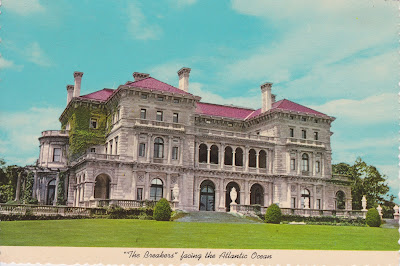The Breakers, Newport, Rhode Island – facing the Atlantic Ocean
This unused, deckle-edged color postcard was labeled “International” published for John M. Twomey Distributing Co., of Newport, Rhode Island using Curteich® 3-D natural color reproduction. Deckle-edged cards were popular from the 1930s to the 1950s. The card also has B-3 and D-14406 as an identifiers located in the upper right of the reverse where the stamp is to be placed. The blurb at the lower left on the reverse describes the picture as “The Breakers facing the Atlantic Ocean, Cornelius Vanderbilt Mansion, Newport, R.I. Open to visitors, May thru October, under auspices of the Preservation Society of Newport County.”
Built between 1893-1895 as the summer home for Cornelius Vanderbilt II, this 70-room mansion was designed by Richard Morris Hunt with interior decoration by Jules Allard and Sons and Ogden Codman. It is a five-story structure with 62,482 square feet (5,804.8 m) of living space. The estate covers 14 acres with the house occupying about 1 acre. It sits on the cliffs overlooking the ocean. Although not visible on the card there are sculpted iron gates at the Ochre Point Avenue entrance, and 30-foot high walkway gates as part of a 12-foot high limestone and iron fence that borders the property except on the ocean side. It is one of the most visited house museums in American with almost 500,000 visitors last year.
At the time Vanderbilt purchased the property in 1885 there was an existing mansion that burned in 1892. Following the fire Vanderbilt commissioned Richard Morris Hunt to rebuild it in splendor. The house was to be as fireproof as possible with steel trusses and no wooden parts. The boiler was to be in an underground space below the front lawn and located away from the house. The interior designers used imported marble, rare woods and mosaics from all around the globe. This mansion is considered a representation of the “Gilded Age” and was the largest most opulent house in the Newport area built to rival the European aristocratic lifestyle.
When Vanderbilt died in 1899 the estate was left to his widow, Alice Gwynne Vanderbilt who lived until 1934. At her death it passed to her youngest daughter, Countess Gladys Szechenyi, who had always loved the estate and had no other American property and whose other siblings had no interest in it.
Like European mansions The Breakers also has formally landscaped gardens with clipped hedges and tree-shaded foot-paths. Flowering plants like rhododendrons, alyssum, ageratum and dogwoods are among the plants that grow in beds that make designs or screen the grounds from street traffic and provide seclusion.
For detail information about the rooms and furnishings and photographs of the grounds and the interior, see:
https://en.wikipedia.org/wiki/The_Breakers

No comments:
Post a Comment